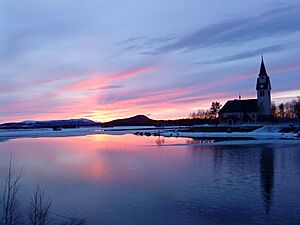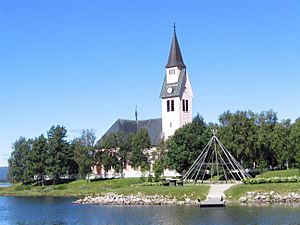Arjeplog Municipality facts for kids
Quick facts for kids
Arjeplog Municipality
Arjeplogs kommun
|
||
|---|---|---|
 |
||
|
||
 |
||
| Country | Sweden | |
| County | Norrbotten County | |
| Seat | Arjeplog | |
| Area | ||
| • Total | 14,594.73 km2 (5,635.06 sq mi) | |
| • Land | 12,804.48 km2 (4,943.84 sq mi) | |
| • Water | 1,790.25 km2 (691.22 sq mi) | |
| Area as of January 1, 2010. | ||
| Population
(June 30, 2012)
|
||
| • Total | 3,136 | |
| • Density | 0.21487/km2 (0.55652/sq mi) | |
| Time zone | UTC+1 (CET) | |
| • Summer (DST) | UTC+2 (CEST) | |
| ISO 3166 code | SE | |
| Province | Lapland | |
| Municipal code | 2506 | |
| Website | www.arjeplog.se | |
Arjeplog Municipality is a special area in northern Sweden. It is part of Norrbotten County. The main town, or seat, of this municipality is Arjeplog.
This area used to be a single parish (a type of church district). It became a municipality in 1863 when Sweden started its first local governments. Arjeplog Municipality is one of the largest in Sweden by land area. However, it has very few people living there, making it the least crowded municipality in the country. Most people live in the small town of Arjeplog.
Contents
History of Arjeplog
People have lived in the Arjeplog area for a very long time. They arrived about 10,000 years ago, after the last ice age ended. For many years, only the Sami people lived here. The Sami are a group of people who have their own language and traditions. They traditionally fish, hunt, and raise reindeer in northern Sweden. Today, they are recognized as a special minority group in Sweden.
In the 1600s and 1700s, only a few hundred people lived in the area. Most were Sami, and the rest of Sweden didn't know much about them. In 1640, Queen Christina of Sweden ordered a church to be built in Arjeplog. This was to help teach the Sami people about Christianity. The church opened in 1642.
Silver Mining in Arjeplog
Interest in Arjeplog grew when silver was discovered there in the 1620s. A mining operation started in 1635 and lasted until 1659. It is thought that about 36 kilograms of silver were mined each year.
In August 1659, soldiers from Denmark–Norway attacked and burned down the mining village. This stopped the silver mining for 120 years.
Mining started again in 1719. This was likely to help King Charles XII of Sweden pay for his wars. The mines kept working until 1810. They closed because there wasn't much profit, the weather was very harsh, and the distances were too long. You can still see old mining remains in the village of Adolfström.
Many places in the area remind people of its silver history. For example, there's Silvervägen (meaning "Silver Road") and Silversundet (meaning "Silver Strait"). In 1965, a Sami museum was built in Arjeplog town. It was named Silvermuseet ("The Silver Museum"). It has many Sami photos and old tools.
Geography and Nature
Arjeplog Municipality is the fourth largest municipality in Sweden by size. But it is also the fourth least populated. It is located by Lake Hornavan, which is Sweden's deepest lake and one of its largest. The municipality is popular because of the beautiful scenery around Lake Hornavan and its untouched nature.
The land in Arjeplog Municipality is mostly covered by the Scandinavian Mountains. It also has many lakes and streams. There are about 8,000 lakes and streams in total! Three main rivers flow through the area: Pite River, Skellefte River, and Lais River. The Skellefte River flows south from Lake Hornavan. It then goes southeast towards Skellefteå and the Gulf of Bothnia on Sweden's east coast.
About 80 kilometers north of Arjeplog town, you can find the national parks Padjelanta and Sarek. Both of these parks are in the western part of Jokkmokk Municipality.
Arjeplog Municipality also has 13 nature reserves. These are mostly mountain areas with open land. Rare plants that are at risk of disappearing grow there. The mountain Galtispouda is 800 meters high. It is a popular place to enjoy the view, a nature reserve, and a great spot for skiing in winter.
Main Town in Arjeplog
There is only one main town, or locality, in Arjeplog Municipality:
| # | Locality | Population |
|---|---|---|
| 1 | Arjeplog | 1,947 |
People and Elections
In 2022, Arjeplog Municipality had 2,705 residents. Of these, 2,126 were Swedish citizens old enough to vote. About 83% of people aged 20-64 had jobs. Most residents (88%) were born in Sweden with Swedish parents. About 12% had foreign heritage. The average monthly income for adults was around 23,823 Swedish kronor. About 27% of adults had a college degree.
When people voted in the 2022 Swedish general election, 53.6% voted for parties on the left side of politics. 45.6% voted for parties on the right side.
Voting for the Swedish Parliament
Here are some results from elections for the Swedish Riksdag (Sweden's parliament) since 1973. "Turnout" shows how many eligible voters actually voted. "Votes" shows the number of valid votes.
| Year | Turnout | Votes | V | S | MP | C | L | KD | M | SD | Other |
|---|---|---|---|---|---|---|---|---|---|---|---|
| 1973 | 86.6 | 2,706 | 22.9 | 45.9 | 0.0 | 19.6 | 5.1 | 2.3 | 3.7 | 0.0 | 2.8 |
| 1976 | 87.4 | 2,751 | 17.1 | 48.2 | 0.0 | 20.9 | 6.5 | 2.1 | 4.5 | 0.0 | 2.8 |
| 1979 | 86.6 | 2,717 | 17.1 | 48.1 | 0.0 | 15.8 | 7.1 | 2.3 | 7.5 | 0.0 | 4.4 |
| 1982 | 86.2 | 2,668 | 15.6 | 51.1 | 1.0 | 15.5 | 3.0 | 2.8 | 10.1 | 0.0 | 4.7 |
| 1985 | 83.9 | 2,613 | 16.1 | 50.1 | 0.8 | 14.3 | 9.0 | 0.0 | 9.4 | 0.0 | 1.0 |
| 1988 | 82.4 | 2,449 | 16.6 | 48.9 | 5.0 | 12.7 | 8.1 | 2.8 | 5.4 | 0.0 | 3.3 |
| 1991 | 82.6 | 2,383 | 11.0 | 48.9 | 2.2 | 11.8 | 5.6 | 5.5 | 9.8 | 0.0 | 7.4 |
| 1994 | 83.6 | 2,361 | 13.8 | 55.9 | 5.0 | 8.3 | 3.9 | 2.9 | 8.7 | 0.0 | 1.5 |
| 1998 | 79.0 | 2,166 | 24.6 | 44.2 | 3.9 | 6.0 | 2.7 | 7.6 | 7.5 | 0.0 | 3.5 |
| 2002 | 77.0 | 1,981 | 14.8 | 45.7 | 4.5 | 9.2 | 5.4 | 5.6 | 3.8 | 0.0 | 11.0 |
| 2006 | 78.3 | 1,955 | 14.5 | 45.0 | 3.2 | 10.3 | 6.1 | 4.8 | 10.7 | 1.7 | 5.4 |
| 2010 | 79.4 | 1,973 | 11.7 | 46.7 | 4.6 | 5.8 | 5.9 | 4.9 | 14.5 | 4.9 | 1.0 |
| 2014 | 80.3 | 1,851 | 12.0 | 44.2 | 3.5 | 6.9 | 3.3 | 3.5 | 9.8 | 14.8 | 2.0 |
Sister Cities
Arjeplog Municipality has two sister cities. These are towns that have a special friendship and cultural exchange:
See also
 In Spanish: Arjeplog para niños
In Spanish: Arjeplog para niños



